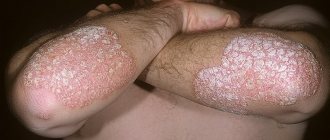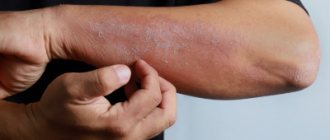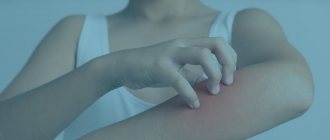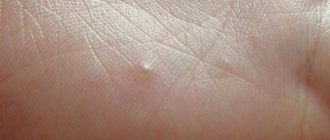Dermatovenerologist
Khasanova
Alina Rashidovna
9 years experience
Make an appointment
Eczema is a chronic skin pathology that manifests itself in the form of foci of inflammation on the body, arms, legs and head. Rashes that form on the skin go through several stages of development: primary redness, dense nodules that transform into blisters, then weeping erosions form, which during the healing process are covered with a scab (the so-called “crust”). The last stage is peeling. Against the background of eczema, secondary purulent infections often develop. If left untreated for a long time, cosmetic defects of the skin may appear in patients of all ages.
Causes
The cause of eczema is the body’s reaction to a variety of factors: chemical, infectious, medicinal, physical.
This reaction can be genetically determined (up to 60% if both parents have eczema) and consists of a complex of inadequate reactions of the body’s immune, nervous and endocrine systems to antigens. Why hands? Our hands come into contact with a huge number of different substances and environments: microbes and fungi, various detergents and cleaners, antiseptics (even in soap), temperature effects, prolonged exposure to water, professional contact with various aggressive chemicals. It is not surprising that at some point the body can malfunction and react violently to a seemingly ordinary stimulus.
Eczema - symptoms and treatment
During the course of the disease the following stages :
- Erythematous - skin redness, swelling and itching appear.
- Papular - red papules (nodules) form.
- Vesicular - grouped bubbles with liquid appear, reminiscent of air bubbles when water boils.
- Weeping - the covers of the bubbles open and weeping and erosion are formed.
- Cortical - areas of weeping dry out and become covered with crusts.
- Peeling – exfoliation of crusts and restoration of the skin surface [2].
As eczema enters the chronic stage, the skin undergoes changes: it becomes rougher and drier, as a result, it flakes and pigmentation appears.
Forms of eczema depending on the clinical picture and causes of occurrence [5]:
- true;
- seborrheic;
- microbial;
- nummular;
- mycotic;
- intertriginous;
- varicose;
- sycosiform;
- nipple eczema;
- children's;
- professional.
True eczema
True eczema most often affects the face and limbs. Areas of healthy and affected skin alternate. Other areas may be involved in the process, including erythroderma (generalization of the inflammatory reaction and fever). The process is usually symmetrical. In the acute stage, the disease manifests itself in the form of blisters (vesicles), redness of the skin, erosions with weeping, crusts, excoriations (mechanical damage to the skin when scratching), there may be papules and pustules. Eczematous lesions have uneven boundaries. When the disease enters the chronic stage, redness becomes stagnant, areas of cracks and lichenification (thickening of the skin with increased skin pattern as a result of prolonged scratching) appear, the skin becomes rough and dry. Often the process is complicated by the appearance of ulcers caused by the addition of an infection: beta-hemolytic streptococcus or Staphylococcus aureus [1].
Monetoid (nummular) eczema
Nummular eczema occurs mainly in adults. Men get sick more often than women. The highest incidence occurs between 50 and 65 years of age, in both sexes. In women, the first peak occurs between the ages of 15 and 25, when puberty passes and the woman reaches adult height and weight. But in children, nummular eczema is extremely rare. The lesions are often located in the elbows and behind the knees, with the arms being affected more often than the legs.
The pathogenesis of the disease is still unclear. In some patients, foci of chronic infection are detected, including in the oral cavity and respiratory tract. Allergens, such as house dust mites, play an important role in the development of nummular eczema. With the disease, clearly defined coin-shaped plaques of papules and vesicles appear. Characteristic signs include pinpoint weeping and crusting. Crusts can cover the entire area of the plaque, the diameter of which varies from 1 to 3 cm. Itching can be either minimal or severe. In ring-shaped forms of the disease, the manifestation decreases in the central part. Chronic plaques become dry, flaky, and the skin thickens.
Microbial eczema
Microbial eczema is a polyetiological disease. In the pathogenesis of microbial eczema, the skin barrier plays an important role, because one of its main functions is protection. Itching provokes scratching of the skin, damaging the integrity of the skin, and this, in turn, forms an entry point for infection. Exudation (the release of the liquid part of the blood into the inflamed tissue through the vascular wall) creates favorable conditions for the proliferation of microbes.
An important component of pathogenesis is the skin microbiota. In scrapings from the affected skin of patients with microbial eczema, Staphylococcus aureus and hemolytic staphylococcus, yeast fungi, mainly of the genus Candida, are found. Microbial eczema can also be caused by external physical or mechanical irritants. Often, foci of microbial eczema appear around purulent wounds and in places of long-term pyoderma (a purulent skin disease resulting from the penetration of bacteria).
In microbial eczema, the lesions are round or irregular in shape, with clear boundaries, located asymmetrically and limited by a border of exfoliating epidermis. In the center of the lesions, purulent and serous crusts can be seen; after their removal, weeping, reminiscent of “wells,” is discovered. The rash is characterized by intense itching [2].
Seborrheic eczema
Inflammation begins on the scalp and is localized in areas of the skin with the largest number of sebaceous glands. In this way, seborrheic eczema is similar to seborrheic dermatitis. The lesions are localized behind the ears, on the chest, neck, between the shoulder blades, and on the flexor surface of the limbs. The skin within the lesion is hyperemic, edematous, on its surface there are small yellowish-pink papules and greasy yellowish scales and crusts [2].
Varicose eczema
Varicose eczema, as the name suggests, occurs when the patient has varicose veins. The skin of the legs next to varicose ulcers is predominantly affected. The development of this type of eczema is caused by irrational and untimely treatment of varicose ulcers, skin maceration (wrinkling of the skin during prolonged contact with water), and trauma. Varicose eczema causes severe itching. Differential diagnosis, first of all, must be made with myxedema and erysipelas [3].
Sycozyform eczema
The disease occurs against the background of vulgar sycosis - inflammation of the hair follicles as a result of the penetration of staphylococci into them. The pathological process can go beyond the boundaries of hair growth; as a rule, lesions can be found on the upper lip, armpits, chin and pubis. Clinically, sycosiform eczema is manifested by serous wells, severe itching and weeping, and later areas of skin thickening appear [2].
Childhood eczema
The first symptoms can be noticed at the age of 3-6 months. Eczematous areas are symmetrical, the skin within the lesions is brightly hyperemic, swollen, hot to the touch, has a shiny smooth surface, there is weeping, layering and milky crusts. Eczema primarily affects the cheeks, forehead, scalp, ears, buttocks and extremities (usually extensor surfaces). It is characteristic that eczema does not affect the skin of the nasolabial triangle. When sick, children complain of itching and insomnia. Eczema often transforms into atopic dermatitis[5][10].
Eczema of the nipples
Skin breakdown occurs after nipple trauma during breastfeeding. Externally, eczema manifests itself as slight redness, weeping, crusts of blood collections, and in some cases pustules and cracks, usually without hardening of the nipples. As a rule, the eczematous process spreads to both breasts [5].
Occupational eczema
Occurs under the influence of various industrial allergens. The disease can be caused by mercury, various metal alloys, penicillin and semi-synthetic antibiotics, resins and synthetic adhesives. Occupational eczema is more common among workers in various industries, people who deal with various chemicals (chemists and biologists), as well as those whose work involves constantly immersing their hands in water (for example, cleaners and orderlies). Under the influence of allergens, a delayed-type hypersensitivity reaction develops. Clinically, occupational eczema occurs like ordinary eczema. The lesions are located mainly in the area of contact with allergens and on open areas of the skin. Occupational eczema is characterized by rapid recovery when the cause disappears [6].
Paratraumatic eczema
Occurs in the area of postoperative scars or with incorrectly applied plaster casts. Manifests itself in the form of acute inflammatory erythema (redness), pustules or papules, and crusting. Hemosiderin, a yellow pigment formed during the breakdown of hemoglobin, can be deposited in the affected tissues [5].
Forecast
The prognosis for eczema is most often favorable.
If you start proper treatment in time, you can curb the disease and get rid of its consequences. With adequate therapy, itching and elements of the old rash disappear, a new rash does not appear. Eczema is a chronic disease, so it is worth adhering to preventive measures and maintaining a state of remission. However, the timing of relapse is still unpredictable. Doctors give the most favorable prognosis for acute eczema. Recovery may be worse if eczema develops in young children, the elderly, or people whose bodies are weakened by infection. To enhance drug treatment, a hypoallergenic diet, physical activity, walking and hardening will help.
Sources
- National Center for Health Statistics, National Health Interview Survey, 2014.
- National Eczema Association website. Eczema causes and triggers.
- Thomas N. Helm and all. What is the role of neomycin in the etiology of allergic contact dermatitis? Medscape. -2020
- Susana Vilaça and all. Simultaneous contact allergy to neomycin, bacitracin, polymyxin, and dexamethasone: An often unrecognized cause of allergic contact dermatitis in patients using topical antibiotics. Journal of the American Academy of Dermatology. -2012, -V. 6, -I. 4, -S. 1, -P. AB74. https://doi.org/10.1016/j.jaad.2011.11.316
- A. C. de Groot, A. Herxheimer. Isothiazolinone preservative: cause of a continuing epidemic of cosmetic dermatitis. Lancet. -1989. DOI: 10.1016/s0140-6736(89)91318-4
- Atopic Dermatitis 101 for Adults. National eczema association. -2017
- JI Silverberg and all. Symptoms and diagnosis of anxiety and depression in atopic dermatitis in US adults. British Journal of Dermatology. -2019. https://doi.org/10.1111/bjd.17683
- A. Wollenberg and all. Consensus-based European guidelines for treatment of atopic eczema (atopic dermatitis) in adults and children: part IJ Eur. Acad. Dermatol. Venereol. -2018. DOI: 10.1111/jdv.14891
- John Elflein. Global use of prescription topical treatments and phototherapy for eczema 2022. -2020
- C. Fookes. Topical Steroids. Drugs.com. -2018
- A. Roeder and all. Safety and efficacy of fluticasone propionate in the topical treatment of skin diseases. Skin Pharmacol. Physiol. -2005. DOI: 10.1159/000081680
- NHS. Topical corticosteroids
- Give Topical Steroids the Fingertip. National eczema association
- Instructions for the medical use of the drugs FeniVate cream RU P N012556/01 dated 07/15/2009 and FeniVate ointment RU P N012556/02 dated 07/16/2009.
- New, sales start in June 2022.
- Katsambas A.D., Lotti T.M. European treatment guidelines in dermatology. 2014, MEDpress-inform LLC, 3rd ed., trans. from English, 736 p.
- Ellie Choi and all. Efficacy of targeted education in reducing topical steroid phobia: A randomized clinical trial. Journal of the American Academy of Dermatology. -2020. -V. 83, -I. 6. -P. 1681-1687. https://doi.org/10.1016/j.jaad.2020.02.079
- NIAID. Eczema (Atopic Dermatitis) Treatment
How to cure seborrhea on the hands forever at home: a list of folk recipes
Treatment of seborrheic eczema with folk remedies has been used since ancient times. Alternative therapy is more gentle and has virtually no side effects.
Celandine
Celandine has long been used in folk medicine to treat skin diseases. Products based on it accelerate the healing of erosions and help reduce itching.
Despite the fact that the plant has a lot of positive properties, it is poisonous, so it should be used only according to the recipe.
Sea buckthorn oil
The product moisturizes and nourishes the skin well.
It can be used both for dry eczema and after the formation of weeping due to the development of the weeping form. The oil will speed up the healing of cracks and wounds, relieve inflammation and accelerate skin regeneration. It should be used with Vaseline in a ratio of 1:3. The resulting mass is applied to the affected areas of the hands and covered with gauze on top. Leave for 30-35 minutes. The effect will be noticeable after 7-8 procedures.
Tea tree oil
The essential oil is aimed at reducing inflammation, drying the skin and relieving severe itching. Apply the product only to damaged areas. To do this, mix 1 drop of tea tree oil with a few drops of any other oil.
You can also prepare a bath based on it. Add 7-10 drops of the product to 2 liters of warm water and dip your hands in the container for 15 minutes.
Tar
Birch tar is increasingly popular in the treatment of the disease.
The effectiveness of this natural remedy is recognized by official medicine. With proper treatment, inflammation, itching, irritation can be eliminated and pathogenic microflora can be destroyed.
In a small container mix 1 tbsp. tar, the same amount of heavy cream and add 1 chicken protein. Mix well. Apply the resulting ointment to the affected areas. Do not rinse for 30 minutes.
Raw potatoes
Raw potatoes will help eliminate the symptoms of the disease. Fresh juice from this root vegetable eliminates inflammation and promotes skin healing.
You need to grate 2-3 potatoes on a fine grater, squeeze out the juice and lubricate the affected areas with it. Also, to speed up recovery, it is recommended to drink 100-110 ml of potato juice 15 minutes before meals.
Since the taste of the medicinal drink is quite specific, you can dilute it 1:2 with carrot juice or purified water.
Coltsfoot
This medicinal plant has been used in folk medicine since ancient times. Compresses based on it will help overcome inflammation, itching and flaking of the skin. Effectiveness can be observed after 3-4 procedures.
The herb is ground in a meat grinder or blender bowl. Pour 50-55 ml of warm milk into 1 tbsp. raw materials and leave to infuse overnight.
The resulting pulp is used for a compress, which must be left overnight or for 5-6 hours.
After the time has passed, carefully rinse your hands under warm running water.
Soda and salt
Baking soda in combination with sea salt will perfectly cope with professional and microbial forms of eczema on the hands. The products will destroy pathogenic microorganisms, reduce itching and inflammation. The skin will acquire a healthy appearance.
To carry out the procedure, you should prepare a medicinal bath. Add 1.5-2 tbsp to 2 liters of warm water. soda and 2 tsp. sea salt. Stir and dip your hands in the container for 20-30 minutes.
If after 2-3 procedures you feel dryness and severe tightness of the skin, then the concentration of the solution should be reduced.
Bibliography
- Glukhenky B.T. Immune-dependent dermatoses: eczema, atopic dermatitis, true pemphigus, pemphigoids / B.T. Glukhenky, S.A. Grando. - Kyiv: Health, 1990.-435 p.
- Kubanova A.A. State of the immune system in patients with eczema / A.A. Kubanova, L.L. Vasilyeva, L.V. Alekseeva, N.G. Dmitrieva. // Vestn. dermatol. Venerol. 1983. - No. 8. — P. 16-19.
- Potekaev Yu.O., N.S. Eczema: aspects of history and modern ideas / N.S. 3. Potekaev // Clinical. dermatology and venereology. 2009. -№1. -WITH. 102-107.
- Potekaev, N.S. Eczema: remarks on modern ideas / N.S. Potekaev // Clinical. dermatology and venereology. 2009. - No. 1. -WITH. 67-73.
- Order of the Ministry of Health and Social Development of the Russian Federation dated February 11, 2005 No. 128 “On approval of the standard of medical care for patients with dyshidrotic eczema.” - M., 2005.
- Prilutsky, V.I. Electrochemically activated water: anomalous properties, mechanism of biological action / V.I. Prilutsky, V.M. Bahir. M.: VNIIMT, 1995. - 228 p.
- The use of rozamet cream with an applicator in the complex therapy of eczema / I.V. Khamaganova, J.I.B. Veselova, N.P. Tarabrina et al. // Clinical. dermatology and venereology. 2009. - No. 5. — P. 46-48.
- Elias, PM Lipid and the epidermal water barrier: metabolism, regulation and pathophysiology / PM Elias // Semin. Dermatol. 1992. -Nil. — P. 176-182.
Base oils
These drugs are used in their pure form in the treatment of most dermatitis
When choosing oil, you should pay attention to its manufacturer, brand and production date of the oil.
Sunflower and corn oils
Regular sunflower oil is excellent against eczema due to its high content of vitamin E, which has a restorative effect and helps reduce itching. To make a remedy, you need to mix oil and apple cider vinegar in equal parts, and then smear the drug on eczematous areas. You can wash off the drug after an hour and a half.
Corn oil also contains a lot of vitamin E, but due to the characteristics of its composition, for eczema it can be used not only externally, but also internally (in the absence of problems with the excretory system). Every day during breakfast you can drink 1 spoon (tablespoon or teaspoon) of corn oil. It is not recommended to drink cold water immediately after the procedure.
Ghee oil against eczema
Ghee is traditional butter that has been refined from the milk residue. It is suitable for sensitive skin, because when applied it does not lead to burning or other painful sensations. It can be used equally successfully in children and elderly patients. It is often used to treat allergic eczema.
Sweet almond oil
Fresh almond oil contains oleic and ursolic acids, which have anti-inflammatory and restorative properties. This drug should be used before taking a bath to protect the skin from the drying effects of water for various dermatitis.
Jojoba oil
This is a fairly thick viscous oil that softens and moisturizes pathogenic lesions in dry eczema. It can be used in its pure form. The greatest effect will be obtained when using jojoba oil to treat dry eczema. A small amount of the drug is applied to the skin and washed off after 1-1.5 hours.
Coconut oil and treatment of dermatitis
Classically cold-pressed organic coconut oil is used in the treatment of dry eczema. The product contains fatty acids that have regenerating and bactericidal properties, due to which they effectively fight associated infections. The oil should be applied to the skin with gentle circular movements; it looks solid, but melts beautifully when it comes into contact with your hands. It can not be washed off with water.
Shea or Shea butter is the best cure for eczema
Shea tree oil is considered an important ingredient in drugs against dermatitis of various etiologies. Shea butter helps retain moisture in tissues and cells and promotes collagen growth.
Shea butter contains acids:
- linoleic,
- arachidonic,
- linolenic
Recipe with essential oils
To prepare the mixture you need to mix:
- half a glass of unrefined Shea butter;
- 10-15 drops of oils: lavender,
- geraniums,
- cedar
The oils must be mixed, but not allowed to melt. The prepared product helps to cope with any type of eczema, but its therapeutic effect on childhood dermatitis is especially pronounced. The mixture should be applied to the skin and left on it for 30-40 minutes.
Shea butter and sea buckthorn oil
To prepare the ointment you will need:
- 30 grams of regular sea buckthorn oil;
- half a glass of hard Shea butter;
- 25 grams of calendula oil (or a mixture of calendula flowers and olive oil).
You can also add essential oils (frankincense, patchouli or chamomile) to the ointment. All ingredients should be mixed. It's better to use a blender, but you can also do it by hand. It is better to apply the cream in the evening after washing your face before going to bed. The mixture moisturizes and nourishes the skin.
How to get rid of microbial eczema at home
Experts call traditional methods of treating microbial eczema exclusively as an addition to the main therapy, but not a complete alternative to the use of medications.
The most common recipes used for treatment are:
- 1 liter of boiling water needs to be poured with 50 g of dry crushed celandine. Leave the composition for 3 hours, strain. Soak cotton wool in the infusion and apply to the affected areas for half an hour. Then remove the lotions, after drying the skin, treat it with a drying agent;
- pour a liter of boiling water over 100 g of pine needles and leave for 2-3 hours. Soak gauze in the infusion and apply to the affected dermis. Keep for 30 minutes. Then treat the area with drying powder;
- take 50 g of dry nettle leaves, pour 1 liter of boiling water and simmer over low heat for half an hour. Add 1 tsp. alcohol tincture of propolis. Place the affected area in a warm solution and hold for 40 minutes. After the bath, pat the skin well and treat with a product containing an antibiotic.
Prevention
Basic rules for dealing with exacerbations of eczema diseases:
- Avoid allergens;
- Moisturize your skin;
- Avoid heat and dry air, drink more water;
- Don't be stressed.
Traditional medicine also offers advice on prevention. If you follow these recipes in parallel with the general recommendations, you can forget about eczema for a long time.
- Apply coconut oil after shower to help retain moisture;
- Fish oil is a healing liquid, saturated with omega 3 fatty acids and fat-soluble vitamins, and is an excellent prevention of skin problems.
- Infusion of flax seeds and flaxseed porridge, when consumed daily, prevent exacerbations.











